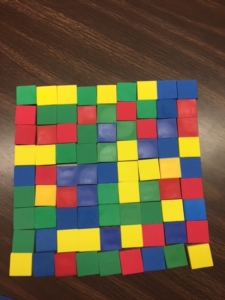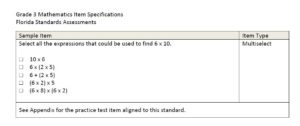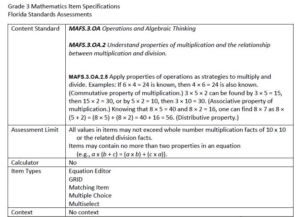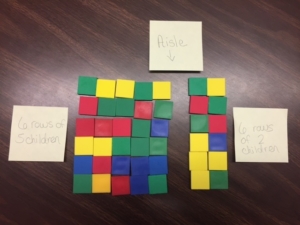Modeling the Distributive Property of Multiplication.
In 3rd grade:
• students explore, discover and understand the distributive property
• are not required to demonstrate understand in the context of a story problem
• are limited to factors 0-10
• are encouraged to model the distributive property with arrays
• record the related expression/equation
Students should explore the distributive property in context, even though it is not assessed in context on the FSA. This will help them see why the distributive property is useful in finding a quick, efficient product.
Example problems may include:
• “Tony has 9 rows and 9 plants in his garden. He wants to separate his garden into tomato plants and watermelon plants with a fence. How might Tony’s garden look?”
• “Ms. Smith took her students to the assembly. She had 6 rows of 7 children. She needs to make an aisle in between the 7 students in each row. Where might she place the aisle?”
From there, students could be encouraged to create models and record expressions/equations for the models. Encourage students to label their models to help them make sense of the problem.
Tony problem example:
• First you would draw the entire garden as an array.

• Then you would choose a place to break apart the garden into the tomato plant section and the watermelon plant section.

• Then record the expression as (9 x 3) + (9 x 4). The product of 9 x 3 = 27. The product of 9 x 4 = 36. 27 + 36 = 63. So the entire garden has 63 plants.
We want students to also explore multiple ways to break apart or decompose factors to find a product more efficiently using the distributive property. For example the problem 4 x 8. I could decompose the problem to be: (4 x 7) + (4 x 1), (4 x 2) + (4 x 6), (4 x 4) + (4 x 4), or (2 x 8) + (2 x 8). You will want to facilitate discussions about which is the most efficient and why, because what’s easier for one student could be different from another student. But most likely students will start seeing that if they can break apart a factor, such as 8, into the same 2 numbers it will make it easier, such as 8 = 4 + 4.
Sample FSA Item Specification problem:

For more information on teaching the distributive property with models in 3rd grade, visit LearnZillion: https://learnzillion.com/lesson_plans/4038-5-solve-multiplication-equations-using-the-associative-property-fp

